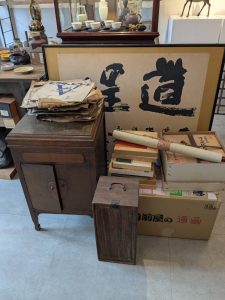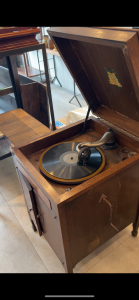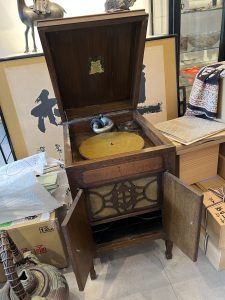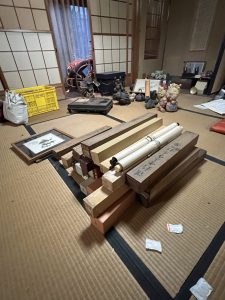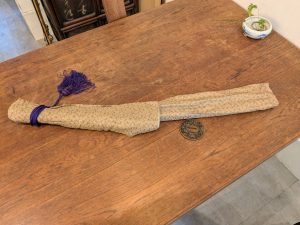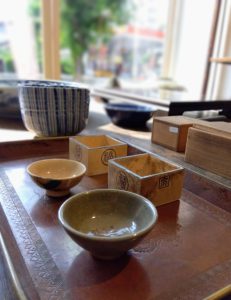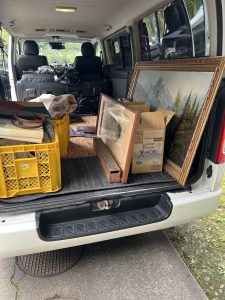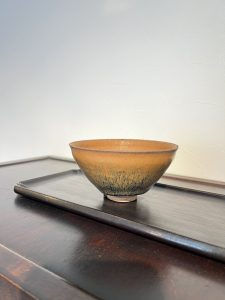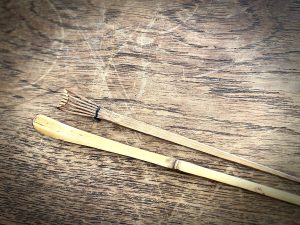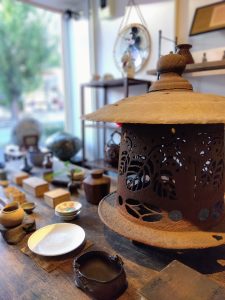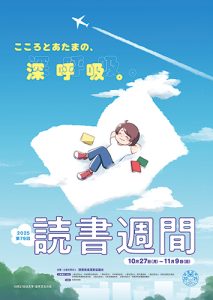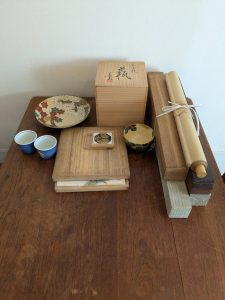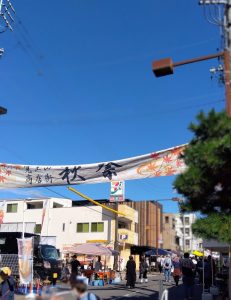
本日は覚王山秋祭が開催されていますので、駅周辺も賑わっておりました。普段なら入るのに勇気が必要で、素通りしていたお店の前にもブースがあり、お店の様子を気軽にのぞくことができそうです。
食べ物ブースのお店の外には椅子なども用意され、お祭りモード全開です。今年は【文化のみち 揚輝荘】も初出店されており、缶バッチ作りなどお子様が喜ぶ体験ができるようですよ。
ここ最近のお祭りの日は、お天気が悪いことが多かったので、久しぶりの今日の晴天は絶好のお出かけ日和ですね。ゆっくり見たいところですが、お仕事がありますので後ろ髪を引かれながら、楽しい気分だけいただいてきました。
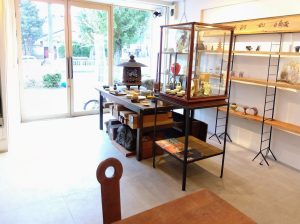
さて、今日から三連休ですね。季節を表す七十二候では「楓蔦黄(もみじつたきばむ)」を迎え、いよいよ紅葉シーズンに入りました。紅葉といえば秋というイメージですが、人にとっては目を楽しませてくれるものでも、木々たちにとっては、色づき、葉を落とすのは、冬も生き残るための大事な手段だからです。
秋に美しく紅葉する木は「落葉樹」と呼ばれています。
木々は、春から夏にかけては、たっぷり日差しを浴びることができるので、光合成を盛んに行い、成長するために必要な栄養をたくさん作ります。
ところが、秋になって日差しが弱くなると、光合成によって作られるエネルギーは激減します。そのため葉を緑色に維持するエネルギーより、光合成によって得られるエネルギーの方が少ないという状態になってしまうのです。
そこで落葉樹は、余分なエネルギーをカットしようと葉に栄養や水分を送ることをやめます。その代わり、枝や幹にエネルギーを蓄え、寒い冬を乗り越える準備を始めるというわけです。紅葉は立冬を迎えると一気に進んでいきますが、今はまだほんの始まりの時期ということになりますね。
夏には緑一色だった山がだんだん色づいてくると、黄、橙、辛子色、赤、紫、その複雑さはしばしば錦の織物に例えられますが、日本はイロハモミジやヤマモミジをはじめとするカエデの種類が多いだけでなく、紅葉、黄葉する植物がたくさんあるためです。
真っ赤に紅葉することが名前の由来になったニシキギ(錦木)、ヤマボウシ(山法師)、コナラ、ケヤキ、ハゼノキなどのウルシの仲間や、ナツハゼ、ドウダンツツジ(灯台躑躅)などのツツジの仲間、黄葉が美しいのはクロモジなどのクスノキの仲間、カツラやダンコウバイ、クヌギ、カラマツ、イチョウなど数えきれないほどあります。
紅葉は日中の天気がよく、夜の冷気が増すほど鮮やかになると言われますが、この寒暖の差が少ない年は鮮やかな紅葉が見られないまま終わってしまうこともあります。やはりメリハリがないと、なんでもぼんやりしてしまうものなのかもしれません。さて、今年はどうなるでしょうか。
ではでは、また(スタッフT)
Today marks the Kakuozan Autumn Festival, so the area around the station was bustling. Even shops I’d normally pass by without entering—places that usually require a bit of courage to walk into—had booths set up outside, making it easy to casually peek inside and see what they’re offering.
Food booths had chairs and tables set up outside, fully embracing the festival spirit. This year, the [Bunkano Michi Yōkizō] is participating for the first time, offering experiences like making can badges that children will enjoy.
Weather has often been bad on recent festival days, so today’s long-awaited sunshine makes it perfect for going out. I’d love to take my time looking around, but work calls, so I left with a heavy heart, taking only the joyful mood with me.
Well, today marks the start of a three-day weekend. According to the seasonal divisions of the 72 micro-seasons, we’ve reached “Maple Vines Turn Yellow,” signaling the full onset of autumn foliage season. While autumn leaves evoke images of fall, what delights our eyes is actually a vital survival strategy for trees: changing color and shedding leaves to endure winter.
Trees that turn beautifully red in autumn are called “deciduous trees.”
From spring through summer, trees soak up plenty of sunlight, actively performing photosynthesis and producing abundant nutrients needed for growth.
However, when autumn arrives and sunlight weakens, the energy produced through photosynthesis drastically decreases. This creates a situation where the energy required to maintain the leaves’ green color exceeds the energy gained from photosynthesis.
Therefore, deciduous trees stop sending nutrients and water to the leaves to cut excess energy. Instead, they begin storing energy in the branches and trunk to prepare for surviving the cold winter. While autumn colors progress rapidly after the start of winter, we are still only at the very beginning of this process.
As mountains that were uniformly green in summer gradually change color, the hues of yellow, orange, mustard, red, and purple become so complex they are often compared to brocade fabrics. This is because Japan not only has many maple species like the Japanese maple and mountain maple, but also numerous plants that turn red or yellow in autumn.
The Japanese spindle tree (Nishiki-gi), whose name originates from its vivid red autumn color, mountain dogwood (yamabōshi), Japanese oak (konara), zelkova (keyaki), and sumac (hazeno-ki) from the sumac family; summer haze (natsuhaze) and Japanese andromeda (dōdantutsuji) from the azalea family; beautiful yellow foliage from camphor trees (kuro-moji) and other laurel family trees; katsura, Japanese spindle tree (dankōbai), Japanese oak (kunugi), larch (karamatsu), ginkgo (ichō), and countless others.
It’s said autumn colors become more vivid when daytime weather is fine and nighttime chill intensifies. Yet in years with little temperature variation, the vibrant foliage may fade away unseen. Perhaps without contrast, everything just becomes blurred. Well, what will this year bring?
Well then, until next time (Staff T)
*******************
ご実家の整理やお片付けなどをされている方のご相談などが多くございます。
お片付けなどくれぐれもご無理のないようになさってくださいませ。
風光舎では古美術品や骨董品の他にも絵画や宝石、趣味のお品など様々なジャンルのものを買受しております。
お片付けをされていて、こういうものでもいいのかしらと迷われているものでも、どうぞお気軽にご相談下さいませ。
また風光舎は、出張買取も強化しております。ご近所はもちろん、愛知県内、岐阜県、三重県その他の県へも出張いたします。
なお、毎月21日の持込鑑定会では無料鑑定・買取・ご相談など、ご予約なしで承っております。
ご近所の皆さま、ご遠方のみなさまも、お気軽にお越しくださいませ。
まずは、お電話お待ちしております。
愛知県名古屋市千種区姫池通
骨董 買取【古美術 風光舎 名古屋店】
TEL052(734)8444
10:00-18:00 OPEN
#出張買取#骨董#古美術#骨董品#絵画#版画#茶道具#刀剣#彫刻
